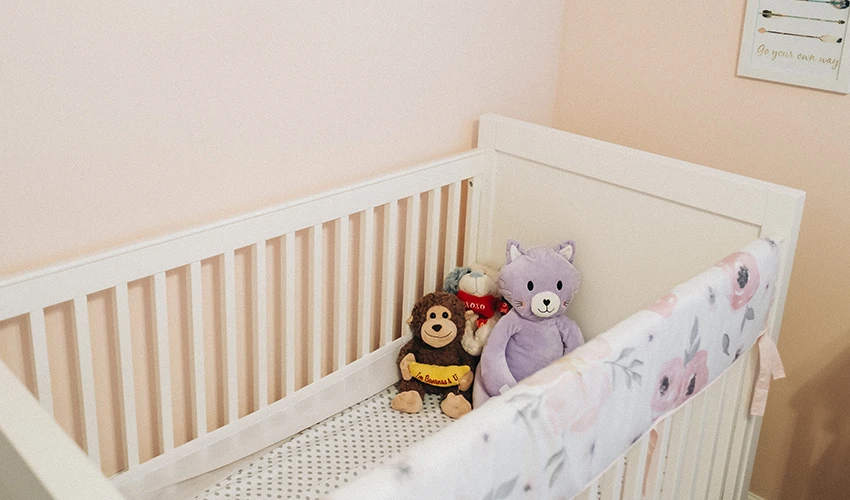Feeling inspired to beautify your baby’s nursery? You may be wondering if it’s safe to paint a crib. In most cases, this can be a safe practice if you follow certain guidelines for crib material, paint selection and ventilation. Before you whip out the paintbrush, read on to learn some tips that could help you paint a crib properly. We will also share how some of our Neighbourly® home service providers can offer inspiration, guidance or services to help you create a comfortable space for your bundle of joy.

Is It Safe to Paint a Crib Made of Wood?
The first step to making a painted crib baby-safe is ensuring the crib material will not flake or peel when painted. Cribs made of wood are typically acceptable for painting. In any case, check the crib manufacturer’s recommendations to determine whether painting is a good choice.
What Type of Paint to Use on a Baby Crib
Here’s what you may want to consider when choosing the right paint for a crib:
- Only choose non-toxic (meaning no silicates or lead), non-odor paint that has zero volatile organic compounds (VOCs). Keep in mind that while the original paint may not contain any VOCs, VOCs are often added when tinting the paint to your chosen colour. Select paints are approved under the SQAQMD-113 regulation, which regulates the VOCs both in the paint base and in tinting agents. It may be prudent to look at a “Waterborne Interior-Acrylic-Enamel” which meets these standards.
- For even greater peace of mind, consider choosing paints that are EN71-3 or ASTM F963-17 certified; these certifications mean the paint should be safe for children’s toys.
- Do not use sealants or paint additives that have not been approved for use on children’s toys or cribs.
- The best paint finish depends on personal preference. Many people choose semi-gloss paint due to its visual appeal, low maintenance and durability when dry.
Crib Painting Guidelines
Here’s how to prepare for the project and plan your technique:
- Wondering if you should be painting while pregnant? Check out this helpful advice from the Five Star Painting® experts before you get started.
- If you are painting over paint, sand the original paint until smooth. Be sure to do this in a well ventilated area and use a mask or breathing protection appropriate for the surface being sanded (N95 or better for wood, N100 or even the P100 respirators for paint which may contain lead, oils or solvents).
- If you are using an older crib, make sure the existing paint is lead-free and non-toxic. When in doubt, scrape it off! If you're unsure or want help, contact one of Neighbourly's local paint experts for peace of mind.
- Have fun with colour! Rather than traditional gendered colours, consider neutral, metallic or bright colours to provide contrast with the nursery décor. Here are some great ideas for gender-neutral nursery colours.
- Choose a high-quality, 100% nylon paintbrush for best results.
- Avoid painting over crib safety components such as screws or latches. If possible, remove them prior to painting and replace once the paint is dry.
- Allow the crib paint to dry in a well-ventilated area; double the typical amount of drying time.
- If you would rather let the pros handle the crib painting project for you, find out if there is a Five Star Painting near you.
How to Paint a Crib the Right Way
Once you have selected the paint you think will keep your baby safe, let the fun begin! Here are the steps for painting the crib:
1. Lightly sand the crib.
Choose a medium 180-grit or fine 220-grit sandpaper or sanding sponge. Scuff sanding enables the new paint to bond optimally. After sanding, wipe away dust with a tack cloth.
2. Apply a primer to the crib.
If your crib is not already painted, or if you are drastically changing the existing colour, apply one coat of primer. If the crib is already painted a colour that’s close to the new one, skip to step 4.
3. Allow the primer to dry thoroughly.
Drying time for primer will vary depending on the manufacturer, the room temperature and the humidity level.
4. Consider lightly sanding again with fine sandpaper.
Unless the paint instructions recommend otherwise, a second, light sanding – also known as “giving it a tooth” – encourages the paint to adhere to the surface. Wipe the area down again with tack cloth.
5. Begin painting the crib.
Apply the paint with a high-quality 100% nylon brush in the direction of the wood grain. Avoid applying a thick coat, which can lead to streaking and dripping. Instead, paint one even coat.
6. Paint a second coat.
Once the first coat is completely dry, apply another coat of paint if necessary, using even brush strokes and smoothing out drips.
7. Dry once more before use.
Allow the paint to dry for twice as long as the paint manufacturer recommends in a well-ventilated area. Open windows and run fans to get rid of any lingering odor before using the crib.
Create a Safe Space for Your Baby
Preparing your baby’s nursery is an exciting time, but it can also lead to some anxiety and worry. Ensuring your baby is safe and comfortable will bring you peace of mind and help you to enjoy this special time. Let Aire Serv® show you how to set the thermostat correctly to make your baby extra cozy.
The Neighbourly family of home service professionals is here to help you along the way – whether you are looking for expert advice or services from our top-notch brands. Search for any home service you need here or in our website menu.


 Back
Back
 1 (833) 339-1953
1 (833) 339-1953




